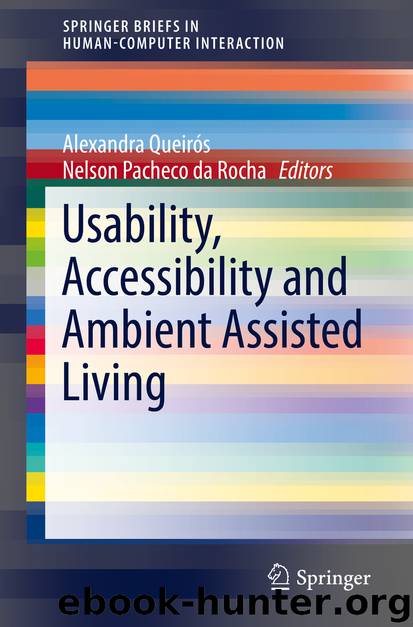Usability, Accessibility and Ambient Assisted Living by Alexandra Queirós & Nelson Pacheco da Rocha

Author:Alexandra Queirós & Nelson Pacheco da Rocha
Language: eng
Format: epub
ISBN: 9783319912264
Publisher: Springer International Publishing
The use of sensors is quite disseminated. One article (Suryadevara and Mukhopadhyay 2014) reports the use of unobtrusive sensors to monitor daily activities and to collect information related to wellness indices. Another article (Stucki and Urwyler 2014) reports the use of sensors to capture environmental variables, such as temperature, humidity, luminescence, motion or acceleration. Moreover, other article (Losardo et al. 2014) was concerned with mobility and reported the use of PIR sensors installed in the bathroom, hallway and kitchen, a bed-occupancy sensor, a sofa-occupancy sensor and a door sensor on the main door. In turn, the Helicopter project developed a sensing network that includes medical devices (e.g. devices to measure blood pressure, body weight, blood sugar and oxygen concentrations), environmental devices (e.g. room presence, bed/chair occupancy, toilet usage, fridge or pantry access) and wearable devices (e.g. devices to estimate physical activity, to detect falls or carrying identification information) (Ciampolini et al. 2016).
Daily activities comprise functional skills as self-care (e.g. dressing, eating or toileting) and mobility (Mlinac and Feng 2016). For example, one article (Niemela et al. 2007) reports the development of systems to monitor medication events or sleep apnoea and to assist older adults giving them the feeling of safety at home. The medication event monitoring uses a smart pillbox that counts the openings and closings of the cap, which is configurable according to the prescription, and the users can access the information through smartphones. The monitoring of sleep apnoea uses a plaster integrated with sensors for detection of brain waves (ECG) and movements of the head. In what concerns to the security at home, Niemela et al. (2007) report a sensors’ network to detect person and animals through infrared motion sensors, door-opening sensors and wearable accelerometers to detect falls. Also, Austin et al. (2016) defined a smart home system to assess loneliness in a continuous and nonobstructive way through sleep hours, the number of incoming or outgoing phone calls, walking speed and mobility. Finally, the SOCIALIZE project uses a network of sensors to promote social relationships (Miori and Russo 2017).
The use of smart devices (e.g. smartphones, smartwatches or smart wrists) was reported in several of the retrieved articles to monitor daily activities. One article (Chiang and Liang 2015) reports the use of simple, low-cost smartwatches and smartphones to detect falls and recognize daily activities. In turn, McCrindle et al. (2011) report the use of a smart wrist to implement an emergency button, a fall detection system and a medication reminder and also to monitor health status (i.e. blood pressure, pulse and temperature). Moreover, Fahim et al. (2012) report a system to remind older adults to perform their daily activities and, through a smartphone, to allow the caregiver to keep track on the older adults’ activities.
The use of a wireless and nonintrusive network of sensors is reported by Suryadevara and Mukhopadhyay (2014) and Stucki and Urwyler (2014) to monitor several activities of daily living as sleeping, grooming, toileting, getting ready for bed, cooking, watching TV or seating. In what concern
Download
This site does not store any files on its server. We only index and link to content provided by other sites. Please contact the content providers to delete copyright contents if any and email us, we'll remove relevant links or contents immediately.
Algorithms of the Intelligent Web by Haralambos Marmanis;Dmitry Babenko(8522)
Test-Driven Development with Java by Alan Mellor(7393)
Data Augmentation with Python by Duc Haba(7296)
Principles of Data Fabric by Sonia Mezzetta(7040)
Learn Blender Simulations the Right Way by Stephen Pearson(6977)
Microservices with Spring Boot 3 and Spring Cloud by Magnus Larsson(6799)
RPA Solution Architect's Handbook by Sachin Sahgal(6210)
Hadoop in Practice by Alex Holmes(6031)
The Infinite Retina by Robert Scoble Irena Cronin(5909)
Jquery UI in Action : Master the concepts Of Jquery UI: A Step By Step Approach by ANMOL GOYAL(5873)
Big Data Analysis with Python by Ivan Marin(5717)
Life 3.0: Being Human in the Age of Artificial Intelligence by Tegmark Max(5402)
Pretrain Vision and Large Language Models in Python by Emily Webber(4679)
Infrastructure as Code for Beginners by Russ McKendrick(4460)
WordPress Plugin Development Cookbook by Yannick Lefebvre(4192)
Functional Programming in JavaScript by Mantyla Dan(4124)
The Age of Surveillance Capitalism by Shoshana Zuboff(4116)
Embracing Microservices Design by Ovais Mehboob Ahmed Khan Nabil Siddiqui and Timothy Oleson(3976)
Applied Machine Learning for Healthcare and Life Sciences Using AWS by Ujjwal Ratan(3954)
